|
|
Bay Middleton

|
|
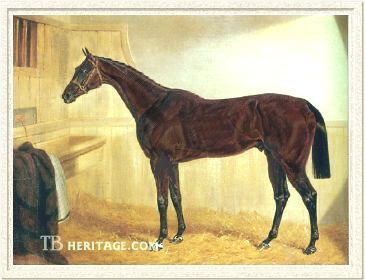 |
|
|
"Born in the purple," as they say, son of a dual-classic winning mare and a stallion that headed the leading sires charts for six consecutive years, Bay Middleton was a brilliant and undefeated winner whose triumphs included two classic races. Considered a comparative failure at stud, given his breeding, his own racing quality, and the quality of the mares who visited him, he still led the sires' list twice in his long life. He got a superior runner in his son, The Flying Dutchman, influential as a sire in England and France, and his daughters, in addition to producing classic winners, bred on, ensuring his presence in the pedigrees of stakes winners throughout the world today.
|
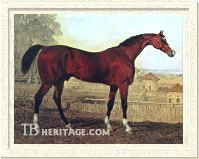
His sire, Sultan
| |
His sire, Sultan, was by the "beautiful" Selim, and out of Bacchante by (Williamson's) Ditto. Selim was one of three famous brothers -- Castrel and Rubens were the others -- and a sister, Oaks winner Bronze, out of an Alexander (son of Eclipse) mare and by the good match horse and sire, Buzzard. The Alexander mare was described as "such a weed to the eye" that she was given away by her owner, and then proceded to produce her influential offspring. Selim won Newmarket's Oatlands twice, and other races, and was "full of quality, and so majestic altogether that no one would have suspected him to be the workman he was at all distances."
|
| Sultan, a flashy red bay, had a refined head, a longish back, great depth through the girth, and a powerful hind-end, the latter something he passed on to Bay Middleton. He was a good and game weight carrier, and was sound enough to run to the age of eight. He won the July Stakes at age 2, the Trial Stakes at Newmarket twice, and a number of other races and matches at Newmarket during his long career; he lost the Derby by a head to Tiresius. Retired to the Marquis of Exeter's stud at Burleigh, he was leading sire in Great Britain for six consecutive years, 1832-37, bolstered by such classic winning sons and daughters as Green Mantle, Galata, Augustus, Ibrahim, and Destiny, Glencoe, and Bay Middleton and his brother, Achmet.
|
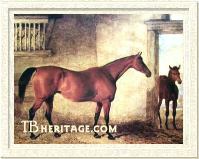
His dam, Cobweb
| |
Bay Middleton's dam, Cobweb, was "Queen of racing mares," unbeaten in her sole season on the turf, winning all four of her races, including the One Thousand Guineas and the Oaks, and retiring sound. Her family had been nurtured in the stud of George Child-Villiers, the fifth Earl of Jersey, at Middleton Park, Middleton Stoney in Oxfordshire, beginning with Web (1808, by Waxy), the sister of those two pillars of the studbook, Whisker and Whalebone. Web had been purchased from the Duke of Grafton, a daughter of the great Grafton foundation mare, Penelope.
|
As foundation mare of the Jersey stud, Web produced Trampoline (1825), by the great four-miler Tramp, was the dam of Glencoe (1831, by Sultan), winner of the Two Thousand Guineas and very influential at stud, particularly as a broodmare sire, both in England and the U.S., and he established a moderately long-lived sire line in the U.S.
Web's daughter Filagree (1815, sometimes "Fillagree") was by St. Leger winner and leading sire (1819) Soothsayer, by the excellent black stallion Sorcerer. For the earl, Filagree produced One Thousand Guineas winner Charlotte West, Two Thousand Guineas winner Riddlesworth, and the dual classic-winner Cobweb, the latter the dam of Bay Middleton.
In addition to Bay Middleton, Cobweb produced his brother Achment (1834), winner of the Two Thousand Guineas, and Clementina (1844), winner of the One Thousand Guineas and other races, and six winners of the important Riddlesworth Stakes (including Bay Middleton and Achmet). Cobweb also bred Young Emilius (1828, by Emilius), purchased to France by the Societe d'Encouragement, where he was a successful sire, getting the champion French runner Fitz-Emilius, Prix du Jockey Club winner Amalfi, and many other good runners.
The Grand Prix de Paris and English Two Thousand Guineas winner Paradox (1882, by Sterling); the significant broodmare La Troienne (1926, by Teddy); the dual-classic winning filly and good broodmare Jest (1910, by Sundridge) and her half-brother St. Leger winner Black Jester (1911, by Polymelus); dual classic winner Royal Palace (1964, by Ballymoss), and many other stakes winners descend from Clementina.
Chart: Bay Middleton's Close-in Female Family
Bay Middleton was Cobweb's seventh foal. For his first few races he ran under the name "Brother to Nell Gwynne." Nell Gwynne was Cobweb's 1831 filly who had served as pacemaker in the 1834 Oaks, won by Pussy. He was a "mottled" bay, darkening as he aged, growing to 16 hands-1/2 inch, with white on three of his coronary bands. His most notable features were his well laid back shoulder, powerful hindquarters -- "his brisket, thighs and hocks, were as good as they could be" -- his arching neck, and his "wicked style of head." Critics noted his short back and "weak" loins, and, according to jockey Sam Day, "stood wretchedly bad on his forelegs upright as a walking stick." But J.F. Herring, who painted him (above) said he had seen no horse that "possessed the heart and muscular power to do what he liked with any horses opposed to him."
Bay Middleton on the Turf
One of the few unbeaten racehorses ever running at the highest level, Bay Middleton had a brief and brilliant career. He was placed in training with Jersey's trainer, James Edwards, who had schooled Jersey's Two Thousand Guineas winners Riddlesworth, Glencoe and Ibrahim (and later Achmet), Derby winners Middleton and Mameluke, and Bay Middleton's dam, Oaks and One Thousand Guineas winner Cobweb.
Bay Middleton was later described as "full of character," but as a youngster his character was exceedingly unruly, and none of Edwards' stable lads would ride him. According to The Druid, Lord Jersey met the great jockey James (Jem) Robinson, who had to that point ridden five Derby winners, by chance in London, and "begged" him to go to the Newmarket stables to ride the horse; when Robinson arrived at the training stable at midnight, Edwards "exclaimed, 'Thank God, you've come. He's bolted with everybody and we'll gallop him in the morning, at the Cambridge Gap." The first meeting of Robinson and Bay Middleton was not promising--the head stable boy let go of Bay Middleton's head just as Robinson was seated, the martingale, which was too short, broke, and the horse "went off like a shot." Once a rider was on him, he would refuse to follow the lead pony. Gradually, Robinson and Bay Middleton came to an understanding, and they never looked back. His reputation as a bad-tempered brute, with his successive wins, was transformed to one of a horse of "very high courage." He was high-strung, and, said The Druid, "To see him curling and twisting up to the post, as was his wont, one would have thought him rather faint-hearted, whereas he was quite the contrary..." He did not start until the age of three in 1836, his only season, and was ridden in all his races by Robinson, who claimed no matter what the distance, he "never heard the horse blow."
His first race, running under the name "Brother to Nell Gwynne," was the Riddlesworth Stakes at Newmarket Craven, which he won in the "commonest of canters," beating five others, including the good filly Mendicant, Destiny (by Sultan), who would go on to win the One Thousand Guineas, and the Zinganee colt Magician. A few days later he took a walk over for £150.
He went on to Newmarket First Spring, where he won the Two Thousand Guineas, beating Elis by a neck, and four others who were distanced by the great speed of the race, which one observer noted, "almost all the accounts gave at the time as a minute and a half, a wondrous flight of speed...but this [time] has never been accepted as the 'official time' or it would have been the mile record." After this he was given his name.
His next stop was Epsom, where he won the Derby, beating an outstanding field of youngsters that included Gladiator, Venison, Slane -- "perhaps the most distinguished cluster of future stud cracks," said The Druid-- and eighteen others. Bay Middleton was in the center of the pack until Tattenham Corner, where he was third, the speedsters Muezzin and Slane having fallen off, with Gladiator in the lead and Venison second. Robinson made his move soon after, and ran level with Gladiator for fifty yards, then Bay Middleton surged ahead to win by two lengths, "...and had a lot left in him at the finish."
Bay Middleton went on to Ascot, where, carrying 9 st.-2, he won the Buckhurst Stakes, beating Muezzin in a canter (8 st-7). In October he went to Newmarket to contest the Grand Duke Michael Stakes; twenty-one subscribers were "frightened out of the field" by him and Elis (ridden by John Day), who had won the St. Leger easily by two lengths.
|
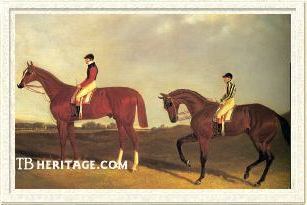
Elis (St. Leger winner) and Bay Middleton (Derby winner) met at the Grand Duke Michael Stakes.
| |
The two-horse race, according to George Tattersall, had a poor pace until the Bushes, "where Bay Middleton went up. At the top of the hill he was leading, and in going down it his wonderful stride enabled him to show his tail to his gallant opponent." Despite John Day's "lavish use of whip and spur to the flanks of one of the best and gamest horses that ever ran," Bay Middleton won by a length, having been touched by the whip once by Robinson, the only time the horse ever felt it. Elis was, Tattersall said, "beaten in pace, stride and stoutness by the winner of the Derby."
|
The last race of Bay Middleton's career was a 300 guineas match at Newmarket Houghton against Muezzin (7 st -13), carrying 8 st-12 lbs. He won this "with ridiculous ease." He was purchased by Lord George Bentinck for the enormous sum of 4,000 guineas, after this race, with the intent he would run in the Ascot Gold Cup the following year, but it was clear a "suspicious" foreleg would not stand the training, and he was retired. The lamness was attributed to a breakdown in the "back sinews," but Bentinck always believed the horse had broken a small bone in his foot.
Bay Middleton at Stud
Bay Middleton was retired to Bentinck's stud, newly formed after his purchase of the "great Jersey bay," at the paddocks next to John Bowe's Turf Tavern in Doncaster at an initial fee of 30 guineas, which later dropped to its nadir of 10 guineas. He was supported by Bentinck with some very good mares purchased specifically with him in mind. Given the quality of his mares, he was considered a comparative failure at stud, like many superior racehorses who do not reproduce themselves. Bentinck died suddenly in 1848, and Bay Middleton was purchased by E.L. Mostyn. The stallion Lord Clifden was brought to Doncaster paddocks to suceed Bay Middleton.
Towards the end of his life Bay Middleton stood for 50 guineas, a very high fee matched only by his son, The Flying Dutchman (at Rawcliffe Paddocks), at Danebury, near Stockbridge in Hampshire, where he died on November 17, 1857, after a long illness, his feet kept in "perpetual turnip poultices." He was buried near his stable door, and a year later the great dual classic winning mare Crucifix, dam of his son, Cowl, was buried next to him. Their graves, planted with flowers and a cedar tree each in their memory, were enclosed by paling.
Despite leading the sire's list in England twice, in 1844 (with 48 winners), and in 1849 (with 28 winners), Bay Middleton was not a blockbuster sire; his only truly great offspring was The Flying Dutchman, who later became a significant sire. What he did get were good juveniles and horses that did well over a bit of ground. Some contemporary turf observers disliked his youngsters, with one describing his offspring as "leggy, tall, overgrown, and weak, and in many instances roarers, their only forte being speed." He did get quite a few offspring with a club foot, something attributed to Cobweb's grandsire, Soothsayer. But a number did well in races up to two miles, and he had quite a few winners, overgrown or not, of important juvenile races. He got four classic winners: Derby and St. Leger winner The Flying Dutchman, Derby winner Andover, Two Thousand Guineas winner The Hermit, and One Thousand Guineas winner Aphrodite.
|
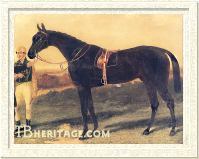
The Flying Dutchman
| |
THE FLYING DUTCHMAN (1846) was a superior runner, winner of all but one of his races. He was out of Barbelle, by Sandbeck, the latter a good winner at York and Doncaster. Barbelle was also the dam of the great runner Van Tromp, and of The Flying Dutchman's brother, VANDERDECKEN. The Dutchman, noted for his speed and courage, was an undefeated juvenile whose wins included Newmarket's July Stakes and Doncaster's Champagne Stakes. At three, he was also undefeated, with wins including the Derby, the Bickerstaffe Stakes at Liverpool, the St. Leger, and the Belvoir Stakes.
|
The next year he started by winning the Emperor of Russia's Plate (substitute Ascot Gold Cup) and a stakes at Goodwood, and then ran into the year-younger Voltigeur who beat him in the Doncaster Cup, to the disbelief of many. He won a rematch against Voltigeur the following year at Knavesmire for a 1,000 guineas purse, a race that was memorialized in song and verse.
In the stud he was second in the leading sire's lists in England three times, getting some good winners, such as Guineas winner Brown Duchess and Derby winner Ellington, and some influential broodmares, the most noted of which was Flying Duchess, the dam of Galopin, who had such an influence on bloodlines through his son, St. Simon. Sold at a very high price to the French government, The Flying Dutchman became a potent influence of bloodstock there through his son, Dollar, sire of Upas and Androclès. The Dutchman also had an influence on Australasian thoroughbreds through daughters Waterwitch and Rose de Florence.
|
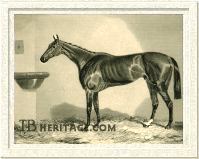
Andover
| |
ANDOVER was a Derby winner for Bay Middleton. He was a bay colt of 1851 out of Sister to Aegis, by Defence. He ran in the colors of John Gully, beginning at age two, when he debuted at Goodwood in the Ham Stakes, running third to Alembic and Sortie. His next outing was the Molecomb Stakes, which he won, beating Mincemeat and others. He won his next two races, both at Brighton -- a sweep for £175, and a 100 sovereign plate, in the latter race beating the future Goodwood Stakes winner Quince, and future St. Leger winner Van Tromp.
|
At age three he won the Epsom Derby by a length over King Tom and THE HERMIT, who had won the 2,000 Guineas, and followed that by winning the Triennial at Stockbridge. This was followed by a walk-over at Goodwood for £125, and then a win in Brighton's Champagne Stakes. His first loss at age three was to the two year old Vengeance (first called The Chicken) in the Eglinton Stakes at Doncaster, where he ran fourth. The last race of his career was the Don Stakes, which he won. He was sold to Sir Tatton Sykes, who put him to stud at his great Sledmere Stud in Yorkshire, but he got little of note and was later sold to Russia.
Bay Middleton's other classic-winning son was the brown THE HERMIT (1851), out of Jenny Lind, by Touchstone. He did not start as a juvenile, being one of those growthy types. His first race ever, running for the partnership of John Gully and Henry Hill, was the Two Thousand Guineas, which he won, beating Middlesex and Ruby. Tried against ANDOVER before the Derby by John Day, who trained both him and Gully's Andover, it was shown that Andover was the better horse, and Gully elected to put Alfred Day on Andover and use The Hermit as a pacemaker. Despite this, he ran third to ANDOVER and King Tom, less than a length separating the three. Gully and the Days won a huge amount of money in the betting of this race. At Ascot that year, he won the Ascot Gold Vase, beating Rataplan by 1-1/2 lengths. He was shipped off to stud duty in Australia, where his most notable contribution was as sire of Ave Maria, dam of Reginald (1881, by Grandmaster), winner of the A.J.C. Autumn Stakes (12 furlongs), Cumberland Stakes (16 furlongs) and A.J.C. Plate (24 furlongs).
|
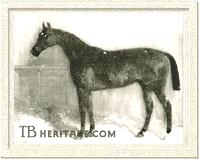
Autocrat
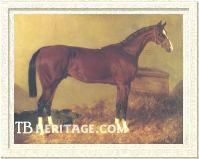
Aristides
| |
AUTOCRAT (1851), out of Empress, by Emilius, was owned by Mr. Cooper, he won Ascot's New Stakes but ran unplaced in Andover's Derby. He got several daughters that bred on, including Queen Elizabeth (1859), dam of Plebian, who, in his only race as a juvenile, beat the great runner Galopin, and later became a successful sire.
Lord Eglinton's ARISTIDES (1840), from the Lottery daughter Rectitude, won two races at age two, including Goodwood's Ham Stakes, considered a promising juvenile. He won two races at age three, but was unplaced in the Derby and St. Leger, and "turned cur" in the rich 500 sovereign sweepstakes at Liverpool July, contributing to the reputation of "softness" in Bay Middleton's offspring. At age four he won two races at Goodwood -- the 300 sovereign sweepstakes in which he beat Derby winner Cotherstone (who broke down in the running) and the Maidstone Stakes -- and a race at Eglinton Park at age five. Another Bay Middleton son that met Cotherstone was GAPER (1840), who beat Cotherstone and others in the Criterion at Newmarket Houghton as a juvenile, but at age three did not place in Cotherstone's Derby, ran third to him in the Gratwicke Stakes, was beaten by a "rank outsider," Decisive, in Stockbridge's Great Produce Stakes, and finally won the Bickerstaffe Stakes at Liverpool. He was later a hunter sire who got "very good fencers, but their forelegs are sadly deficient."
|
COWL (1842), from Lord George Bentinck's great racemare Crucifix, won Newmarket's Buckenham Stakes in a canter as a juvenile in 1844. Bentinck had not nominated him to the Derby, but he won the Ascot Produce Stakes in 1845, and the next day ran third to The Emperor and Alice Hawthorn in the Emperor's Plate, falling lame during that race. His career ended during the Gratwicke Stakes at Goodwood, when he dislocated both hind pasterns. He was a moderately successful sire and his daughters' success at stud ensured that he was seen in pedigrees for decades into the future.
One Cowl daughter, the fast, non-staying Mme. Eglantine was later dam of such good runners as Rosicrucian, The Palmer, and Morna, and the broodmares Monaca, Chaplet, Jocosa, and Frivola, all but Jocosa and Frivola by Beadsman. Monaca was the dam of Stewards' Cup winner Monaco; Chaplet was the dam of the brothers Ascot Gold Cup winner Morion and Winkfield (sire of Ascot Gold Cup winner Bachelor's Button and Doncaster Cup winner Winkfield's Pride), and daughters that bred on; Jocosa produced Woodcote Stakes winner Sabella and her branch bred on; Frivola also established a long-lived female line. Another Cowl daughter, Morgan La Faye won two races as a juvenile and was dam of Oaks winner Marie Stuart; horses such as White Eagle, English Triple Crown winner Galtee More and Derby winner Ard Patrick descended from Morgan La Faye.
The Velocipede daughter Blue Devils (1837) was in Bentinck's stud, where she was bred succcessively to Bay Middleton between 1840 and 1850. Her best from these matings was her daughter ENNUI (1843, see below), a winner and later a great broodmare. Another product of this breeding was THE-DEVIL-TO-PAY (1841) owned by Bentinck, won the Gorhambury Stakes handicap and ran second in the Two Thousand Guineas in 1844 and third in 1845 to Joe Lovell and BEST BOWER (another Bay Middleton son) in a sweep at Goodwood.
Other Bay Middleton sons that did well on the turf were Bentinck's HONEYCOMB (1846, out of Beeswax), fourth to The Flying Dutchman in the Derby of 1849, and fourth to him again in the St. Leger. He was second to Clarissa in a sweepstakes at Goodwood, second to Nunnykirk in the Two Thousand Guineas, and second to Elthiron by a neck in the Ebor St. Leger at York, and in the Grand Duke Michael Stakes with only two running, he was soundly beaten by Vatican. OSTERLEY won the Port Stakes at Newmarket in 1850. BARBATUS (1850, out of Barba by Lanercost), owned by Lord Glasgow, ran third in the 1853 Two Thousand Guineas, beaten by West Australian and Sittingbourne. In 1854, Lord Eglinton's VANDERDECKEN (1850, out of Barbelle), a half-brother to The Flying Dutchman and Van Tromp, ran second to West Australian in the Triennial at Ascot, and third to the great race filly Virago in the Flying Dutchman Handicap. BAVENO ran second to Orlando in the Riddlesworth Stakes at Newmarket.
Bay Middleton's Daughters
As with his sons, Bay Middleton got some good running daughters on the turf, and a number of second tier race fillies. Many proved to be good producers of winners, but it is largely through the longevity, rather than the brilliance, of his daughter's female lines that he is seen scattered in the distance of pedigrees today.
APHRODITE (Family 22 - b), an 1848 filly from the good Sir Hercules broodmare, Venus (dam of Vesuvienne by Gladiator and Mrs. Quickly by Longbow, among others), was probably Bay Middleton's best daughter on the turf. She won the One Thousand Guineas for Sir Joseph Hawley, and later showed she could stay by running a good second to Newminster in the Doncaster St. Leger. She dead-heated with Grecian in the July Stakes at Newmarket, and then lost in the run-off. Her other wins were Doncaster's Champagne Stakes and the Park Hill Stakes. She produced Siderolite, by Asteroid, who won the Ascot Gold Vase and the Goodwood Cup, and Argonaut, by Stockwell, who won the 1865 1-1/4 mile City and Suburban Handicap at Epsom.
ELLEN MIDDLETON (1846), from Myrrha (Family 7) by Malek, was a 16 hand tall mare whose only conformation fault was being a bit straight in the hocks. She was a fair two year old, who ran second in Doncaster's Champagne Stakes to The Flying Dutchman and won the filly Sapling Stakes at York in 1848, and at age three won the Yorkshire Oaks and ran second to Oaks winner Lady Evelyn in the Doncaster Park Hill Stakes in 1849. The following year she was purchased sight unseen by Francis Popham, on the advice of his groom, for whom she bred Derby winner Wild Dayrell (1852, by Ion), also winner of the Ebor St. Leger, the Queen's Vase at Ascot, the Stockbridge Stewards' Cup, and other races, and later a good sire of such horses as Buccaneer, The Rake, and Wild Oats. Wild Dayrell purportedly bore a "striking resemblance" to Bay Middleton. Through her daughters, Ellen Middleton was tail-female ancestress of horses such as American Flag, Sandjar, the Prix de Diane and l'Arc de Triomphe winner La Sorellina, Derby winner Watling Street, and the top U.S. racemare Susan's Girl.
Ellen Middleton's sister, MESSALINA (1840), owned by General Sharp, ran unplaced in the 1843 Oaks; she bred on, with some great French runners -- Fervacques (Grand Prix de Paris), Saltarelle (Prix du Jockey Club), Salteador (Prix Daru, Prix Lupin, others) and sire Saxifrage, all offspring of her daughter Slapdash (1855, by Annandale).
Other Bay Middleton daughters who ran well included Lord George Bentinck's sturdy ALL-ROUND-MY-HAT (1842), out of another good running mare he purchased specifically for Bay Middleton, the 1837 One Thousand Guineas winner Chapeau d'Espagne (1834, by Doctor Syntax). All-round-my-Hat was second to future Oaks winner The Princess in Doncaster's Two Year Old Stakes, and won £450 at Stockbridge and Liverpool, £800 at Newmarket, and the Nassau Stakes, in the latter beating The Princess. She ran fourth in Doncaster's Park Hill Stakes, and fifth and last in the Grand Duke Michael Stakes. ENNUI (1843, sister to THE-DEVIL-TO-PAY), from the Velocipede daughter Blue Devils, won the 300 sovereign sweeptstakes at Goodwood in 1847. ROSE OF CASHMERE (1842) won the Nursery Stakes (2nd class) at Newmarket Houghton, and later produced some good runners, including Eccleston (1851, by Touchstone), and Wild Rose.
PRINCESS ALICE (1843, from Her Majesty by Velocipede) was another good juvenile by Bay Middleton, winner of Doncaster's Champagne Stakes and the Nassau Stakes.
Bay Middleton's daughter HYBLA (1850) out of Beeswax (half-sister to the great Beeswing), won the New Stakes but failed to place the next year in the Oaks; she was one of four siblings out of Beeswax, but her own production record was cut short, when she died after producing one foal. Her brother, HONEYCOMB (1846, see above) was a good runner.
PUG (1845), another Bentinck-owned and bred Bay Middleton filly, ran third in the Somersetshire Stakes at Bath when she was three years old. In 1850, ELIZA MIDDLETON won a handicap sweepstakes worth £200 at Newmarket Second October, beating Oaks winner Rhedycina. Lord Dorchester's MICHAELMAS MAID (1850) ran second to future Oaks winner Catherine Hayes at age 2 in a small race at Salisbury, at age age four won the four-furlong Sussex Stakes at Brighton and decisively beat William Rufus in a 100 sovereign match at Reading. None of these Bay Middleton daughters produced significant winners or established long-lived female lines.
Bay Middleton was a successful broodmare sire; his daughters produced Wild Dayrell, a Derby winner; Eclipse, a fast colt who was a highfly influential sire in America; St. Leger winner Sunbeam, Goodwood Cup winner Saunterer, and a host of other good winners, in addition to those noted above.
His most notable grandsons were the Derby winner Wild Dayrell, out of daughter ELLEN MIDDLETON, and (American) Eclipse, out of GAZE.
GAZE (1842) was an unraced sister to Criterion Stakes winner GAPER, mentioned above. Their dam was Flycatcher (1831, by Godolphin), a half-sister to the (5th) Earl of Jersey's Two Thousand Guineas winner Ibrahim (by Sultan) and Oaks winner The Princess (by Slane). Gaze passed into the hands of Charles Fulke Greville, who owned Derby winner and multiple champion sire Orlando. Her 1855 chestnut colt by Orlando, named Eclipse, ran for Henry Padwick as a juvenile and part of his three-year-old season, and then was sold to American Richard Ten Broeck, for whom he ran twice more before he broke down. A winner of Newmarket's Clearwell Stakes, Ascot's First Biennial Stakes and several other races, and noted for his speed, he was shipped off to America in 1859, and there proceeded to get many fast youngsters, founding a dynasty through his son Alarm, which led to the influential Domino.
Bay Middleton's daughter ENNUI (Family 27 - a), noted above, produced Goodwood Cup winner and sire Saunterer (by Birdcatcher), Loiterer (by Stockwell), and Lady Rodem (by West Australian), the latter the dam of the top juvenile Liddington (winner of the Chesterfield Stakes, Newmarket's July Stakes and Ascot's New Stakes). Ennui's daughter Bravery, produced the Ascot Gold Cup winning filly Rupee (1857), by The Nabob, and her half-sister Salamanca, dam of the great runner Pero Gomez (St. Leger and other races) and of daughters that bred on; 1923 Preakness Stakes winner Vigil and 1927 Two Thousand Guineas winner Adam's Apple descended from Salamanca. Liddington's half-sisters, Mirella (1863) and Lady Coventry (1865) also bred on: the siblings Energy, Cherry Ripe, Dorothea and Two Thousand Guineas winner Enthusiast (all out of Cherry Duchess and by Sterling) were grandchildren of Mirella; this was the family of New Zealand champion Enthusiasm, of He Goes, Alsab, and German Derby winner and sire Landgraf. Horses descending from Lady Coventry included the great French runner Semendria (1897, by Le Sancy), from whom Biribi (1923, Arc de Triomphe and others), La Rayonne and Le Tourbillon descended. Ragotsky, Farnese, Lady Golightly, and Anilin were also descended from Lady Coventry.
SUNFLOWER (1847), from Io, by Taurus, was one of Bay Middleton's best producing daughters. She was the dam of St. Leger winner Sunbeam (by Chanticleer), and through her was tail-female ancestress of an extremely prolific and successful family of stakes winners in countries all over the world. Sunflower was also the dam of Gimcrack Stakes winner Rainbow (by Chanticleer), of Mayflower, from whom the U.S. stakes winner and sire Celt descended, and of Crocus. English Triple Crown winner Gay Crusader, 1,000 Guineas winner Galeottia, and two Grand National winners, Royal Mail and Well to Do, descend in tail-female from Crocus.
An unnamed Bay Middleton MARE out of the Venison mare West Country Lass, produced the King Tom brothers Ethelred and King Alfred; Ethelred won the July Stakes and the New Stakes, and King Alfred won the Prince of Wales's Stakes. This mare was tail-female ancestress of a number of good stakes winners, including Oaks winner Sun Cap (1951).
Another unnamed Bay Middleton MARE (1839), from the Whisker daughter Apollonia, produced a good running daughter, Princess Royal (1855, by Slane), who won the Gimcrack Stakes and other races. Still another unnamed Bay Middleton MARE (1846, out of Vitula) produced Mayer Rothschild's Orestes (1850, by Orlando), who won Epsom's Woodcote Stakes and the Croxteth Stakes at Liverpool in 1854; he was later sire of the Baron's Orest, grandsire of Irish Grand National winner Eglentine, and of Restes who won Epsom's Woodcote Stakes in 1859. Orestes' half-brother, Pylades (1852) was later sire of the outstanding runner North Lincoln. Another Bay Middleton MARE produced Porto Rico (1853, by Orlando), a good juvenile winner of the Clearwell and Prendergast Stakes at Newmarket, and later sire of the jumper Miltown, who won the 1874 Conyngham Cup.
BRIDAL (1839), from a Whalebone daughter, Goldpin, was the dam of stakes winners: the 1849 Gameboy filly Troussau, who won the Gimcrack Stakes; Fichu (1866, by Ivan), who won the Steward's Cup; and Special License, by Cossack. Another Gimcrack Stakes winner, Barrel (1851, by Faugh-a-Ballagh), was the son of Bay Middleton's daughter DELAINE, out of a Velocipede mare. ADA MARY (1846, out of a Tramp daughter) won York's Convivial Produce Stakes as a juvenile, and later produced Adamas, by Touchstone.
Other daughters who were good producers were APHRODITE, as mentioned above, and BAY LETTY, (1851), from Oaks winner Miss Letty, by Priam, who was the dam of Trial Stakes winner Wolfsberg (by Virgilius).
Other Bay Middleton daughters were second dams of some good horses, among them: an unnamed MARE (1839) from the Whisker mare Nitocris, who was grandam of Fisherman (1853, by Heron), two-time winner of the Ascot Gold Cup, and was third dam of the French sire Gemma di Vergy; BAY MISSY (1842), from Camilla by Young Phantom, was, through daughter Miss Ann (by The Little Known), second dam of Ascot Gold Cup winner and sire Scottish Chief; Ascot Stakes winner Chrypre was the grandaughter of BOUQUET (1856, from Violet by Melbourne).
NUN APPLETON (1845), by Bay Middleton and out of the Malek daughter Miss Milner, produced Attraction (1861), winner of sixteen races, and her sister Julie (1856), who produced Beaufort Cup and Cesarewitch winner Julius (1864) and his brother Royal Hunt Cup winner Julius Caesar (1873). Nun Appleton was also second dam, through another daughter, of Stewards Cup winner Sister Helen, and through yet another daughter of the Grand National Steeplechase winner Voluptuary.
RUSHLIGHT (1841), from the Lamplighter daughter Torch, was second dam of Melbourne Cup and Victoria Derby winner Lantern (by Muscovado). PHYSALIS (1841, from Baleine by Whalebone) produced a daughter by Lanercost or Retriever who produced the good runner Rapid Rhone by Y. Melbourne.
Bay Middleton daughters are seen in the tail-female lines of such horses as Derby winner Aboyeur and the great producer Puntarenas, dam of three top French racehorses, including Palais Royale (by Bruleur); Derby and Grand Prix de Paris winner Phil Drake; the New Zealand classic winner Syntax; Oaks winner Gamos; St. Leger winner Pero Gomez; 2,000 guineas winner Enthusiast; top sire and runner in Germany, Landgraf; top French race filly Semendria, and Arc winner Brantome; the great sires Hurry On and Northern Dancer, and the dual American classic winner Spectacular Bid; and many more stakes winners on every continent.
Bay Middleton was described as "...a magnificent specimen of the racehorse...about the best horse that has appeared in the present [19th] century." When he died a noted turfite memorialized him by stating he "... was a long way the best horse we have seen in this century...He was a horse; take him for all and all, We shall not look upon his like again."
--Patricia Erigero
|
|
|
|

